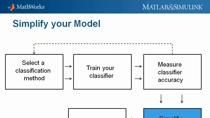ECG Classification Using Machine Learning | AI Techniques for ECG Classification, Part 2
From the series: AI Techniques for ECG Classification
Learn about feature extraction techniques and feature selection techniques, such as minimum redundancy maximum relevance (mRMR), and leverage the built-in apps such as Classification Learner to easily build machine learning models for ECG classification.
Published: 28 Jan 2021





